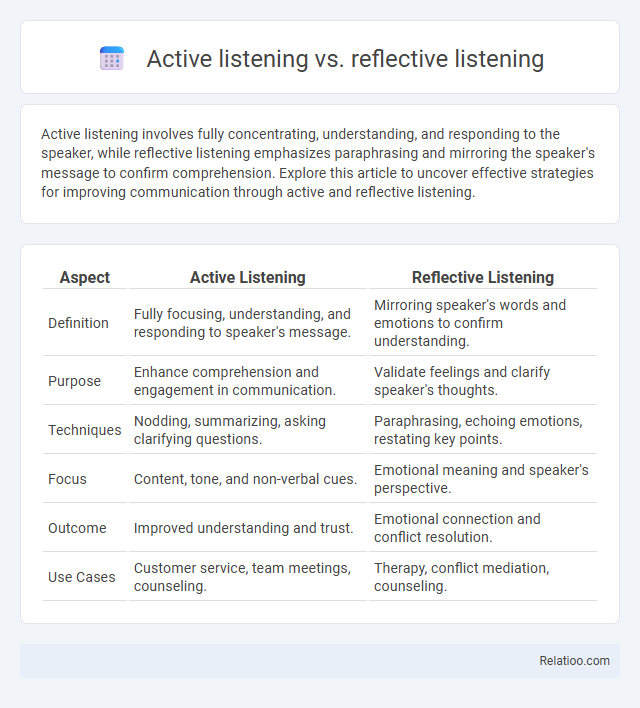Active listening involves fully concentrating, understanding, and responding to the speaker, while reflective listening emphasizes paraphrasing and mirroring the speaker's message to confirm comprehension. Explore this article to uncover effective strategies for improving communication through active and reflective listening.
Table of Comparison
| Aspect | Active Listening | Reflective Listening |
|---|---|---|
| Definition | Fully focusing, understanding, and responding to speaker's message. | Mirroring speaker's words and emotions to confirm understanding. |
| Purpose | Enhance comprehension and engagement in communication. | Validate feelings and clarify speaker's thoughts. |
| Techniques | Nodding, summarizing, asking clarifying questions. | Paraphrasing, echoing emotions, restating key points. |
| Focus | Content, tone, and non-verbal cues. | Emotional meaning and speaker's perspective. |
| Outcome | Improved understanding and trust. | Emotional connection and conflict resolution. |
| Use Cases | Customer service, team meetings, counseling. | Therapy, conflict mediation, counseling. |
Introduction to Listening Skills
Active listening involves fully concentrating, understanding, responding, and remembering what is being said, enhancing effective communication. Reflective listening goes beyond by mirroring the speaker's message and emotions, validating their thoughts and fostering deeper connection. Both active and reflective listening are essential components of listening skills, promoting empathy and clarity in personal and professional interactions.
Defining Active Listening
Active listening is a communication technique that involves fully concentrating, understanding, and responding thoughtfully to the speaker, ensuring their message is accurately received. Unlike reflective listening, which focuses on paraphrasing and echoing the speaker's words to confirm understanding, active listening engages your attention through verbal and non-verbal feedback to foster a deeper connection. Your ability to practice active listening enhances interpersonal relationships by demonstrating genuine interest and empathy.
Understanding Reflective Listening
Reflective listening centers on accurately interpreting and restating the speaker's message to confirm understanding, enhancing communication clarity. Unlike active listening, which involves attentively hearing and responding to content, reflective listening prioritizes empathy and validation by mirroring emotions and thoughts expressed by the speaker. Mastering reflective listening improves interpersonal relationships and conflict resolution by fostering deeper emotional connections and mutual comprehension.
Core Components of Active Listening
Active listening involves fully concentrating, understanding, and responding thoughtfully to the speaker, with core components including paying attention, withholding judgment, and providing feedback. Reflective listening focuses on mirroring the speaker's message and emotions to confirm understanding, often by paraphrasing or summarizing what was said. Your communication skills improve significantly by mastering active listening's core elements, fostering trust and clarity in conversations.
Key Elements of Reflective Listening
Reflective listening centers on truly understanding your speaker by mirroring their emotions and content, emphasizing empathy, clarity, and validation as key elements. Active listening requires full attention and feedback through verbal and nonverbal cues, while passive listening involves minimal interaction. Your ability to practice reflective listening enhances communication by ensuring the speaker feels heard and understood.
Differences Between Active and Reflective Listening
Active listening involves fully concentrating, understanding, and responding to the speaker's message, while reflective listening focuses on mirroring the speaker's emotions and content to confirm understanding. The primary difference lies in intent: active listening seeks to engage and respond constructively, whereas reflective listening prioritizes empathy and validation by restating the speaker's words. Both techniques enhance communication but serve distinct purposes in dialogue and conflict resolution.
Benefits of Active Listening in Communication
Active listening enhances communication by fully engaging with the speaker, leading to better understanding and fewer misunderstandings. You gain clearer insights and build stronger relationships as it encourages empathy and trust. Reflective listening, while valuable, primarily focuses on mirroring content, whereas active listening involves a deeper cognitive process that benefits conflict resolution and collaboration.
Advantages of Reflective Listening in Relationships
Reflective listening enhances relationships by fostering deeper understanding and emotional connection, as it involves carefully mirroring the speaker's emotions and content. This technique reduces misunderstandings and builds trust, promoting a safe space for open communication. Compared to active listening, reflective listening specifically validates feelings, which strengthens empathy and encourages honesty between partners.
Choosing the Right Listening Approach
Active listening emphasizes fully concentrating, understanding, and responding thoughtfully to the speaker's message, while reflective listening involves paraphrasing or summarizing what has been said to confirm comprehension and validate the speaker's feelings. Choosing the right listening approach depends on the context and communication goals, such as using active listening in problem-solving scenarios and reflective listening to build empathy and trust. Effective communication combines both methods to enhance understanding and foster meaningful connections.
Tips for Improving Listening Skills
Improving listening skills involves distinguishing between active listening, reflective listening, and passive hearing. Active listening requires fully concentrating, understanding, responding, and remembering what is being said, with tips including maintaining eye contact, minimizing distractions, and asking clarifying questions. Reflective listening centers on mirroring the speaker's emotions and content by paraphrasing and summarizing, which helps validate feelings and ensures accurate understanding.

Infographic: Active listening vs Reflective listening
 relatioo.com
relatioo.com